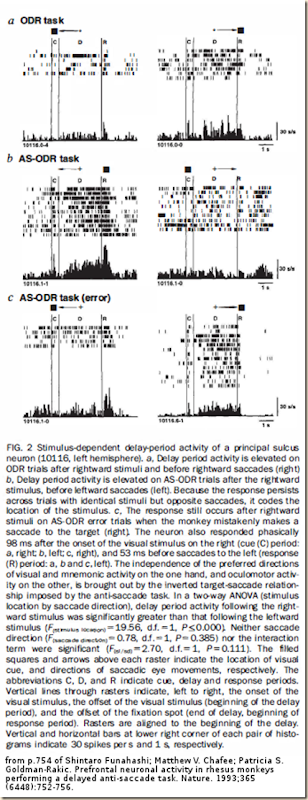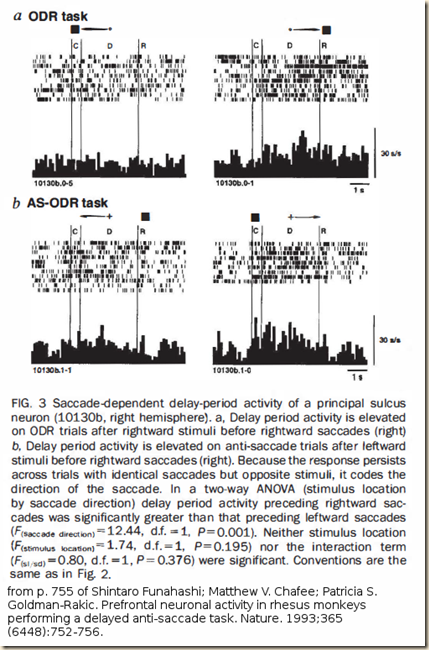by Corry Shores
[Search Blog Here. Index-tags are found on the bottom of the left column.]
[Central Entry Directory]
[Neuro-Science, entry directory]
Shintaro Funahashi; Matthew V. Chafee; Patricia S. Goldman-Rakic
Prefrontal neuronal activity in rhesus monkeys performing a delayed anti-saccade task
Brief summary:
Research suggests that our neurons store information about the past and also prepare for future actions using that information. Information about the past and the future, although not being present to our senses, is processed in our brains in the present.
Notes:
The authors examined the activity of 108 neurons in the dorsolateral prefrontal cortex, concentrating specifically on the delay period activity of these neurons. Two monkeys were to perform the following trial steps:
(1) Fixation on center of screen for 0.75 seconds (s)
(2) A visual cue stimulus is presented to the left or right of the fixation point for .5s [monkey may not move eyes yet]
(3) a period of delay of 3s when only the fixation point shows, and no cue [monkey may still not move eyes yet]
(4) After the delay ends, the fixation target disappears, and the monkey has 0.5s to move either to the side of the screen of the cue or toward the opposite side [depending on how it is to be trained], and upon success, was rewarded with a drop of juice.
 [above from p754 of Funahashi et al.]
[above from p754 of Funahashi et al.]
The results suggests that neurons may exhibit heightened activity during delay periods. But whether or not their activity increases seems to depend on what their role is. It seems that certain neurons are responsible for retaining data of certain kinds, mostly to do with the side that the stimulus is on, regardless of the resulting task or action.
Figure 2 illustrates a principal sulcus neuron whose increased firing in the delay is linked to the location of the visual cue, not the direction of the saccade. First, the neuron responded 98 ms after the onset of the visual stimulus when it appeared on the right but not the left (Fig. 2a, right; b, left; c, right). Second, it showed increased activity on ODR trials during the 3-s delay period, again only after the rightward stimulus (Fig. 2a, right). Third, and most relevant to the memory code, on anti-saccade trials, activity was again elevated in the delay period following the rightward stimulus (Fig. 2b, left), even though the saccade at the end of the delay was directed to the left. Fourth, on AS-ODR error trials, when the monkey mistakenly directed its saccades toward the stimulus, neuronal activity in the delay again reflected the rightward location of the stimulus (Fig. 2c, right). Thus, the response of this neuron in the delay was keyed | to the direction of a preceding stimulus, and not to that of the impending saccade, whether that saccade was correct or incorrect, and whether it was toward or away from the original stimulus. A similar pattern of stimulus dependence was found in the delay period activity of 30 out of 51 (or 59%) of the prefrontal neurons studied. If the 44 histologically verified principal sulcus neurons are considered alone, this percentage rises to 68%. The preponderance of stimulus-dependent delay period activity in this area is strong evidence of a prefrontal specialization for ideational processing that does not rely on a motor code and is not mediated by motor signals.
[p. 754]
[above from p754 of Funahashi et al.]
So the results seen above in figure 2 show us that there are neurons responsible for stimulus-coding. They are called stimulus-coding neurons. [754] During delay periods, these neurons increase activity for stimuli on the right side of the vision, regardless of reactions desired or executed.
There are also a response-coding function.
Activity was greater in the delay before rightward saccades, irrespective of whether the stimulus signalling the saccade had appeared on the right (Fig. 3a, right) or the left (Fig. 3b, right)
[754-755]
[above from p754 of Funahashi et al.]
So these neurons are called response-coding neurons. They are more active during delay periods when the animal will need to later move their eyes, in this case, to the right. This suggests that there are neurons which anticipate future actions.
So, different neurons have different functions, which combine to produce the complex behavior of waiting during delay periods all while retaining the past information during that time.
Independent response-coding and stimulus-coding mechanisms in prefrontal cortex might thus combine to mediate complex cognitive functions.
[755]
And thus because there are neurons which retain information and also ones which withhold actions that will use that information, brains exhibit the ability to process information about the past and future.
Stimulus-coding and response-coding delay period activities have been recorded previously from neurons in the principal sulcus on delayed-response tasks involving manual rather than oculomotor responses. The agreement between those results and our own, obtained with tasks recruiting different motor systems, suggests that the concurrent representation of past stimuli and future actions is a general principle of prefrontal operation. This segregation may enable the flexible re-association of stimulus representations and motor plans on a moment to moment basis on tasks in which stimulus-response relationships are not fixed. Stimulus and response-coding prefrontal neurons may directly or indirectly contribute to activity changes observed in motor areas, such as the supplementary motor area, the motor cortex, and the putamen, where target-dependent and limbdependent preparatory activity have also been recorded during a delayed-response task.
[755]
Shintaro Funahashi; Matthew V. Chafee; Patricia S. Goldman-Rakic. Prefrontal neuronal activity in rhesus monkeys performing a delayed anti-saccade task. Nature. 1993;365(6448):752-756.
http://www.cns.nyu.edu/~wendy/class/2006sp/reading9/Funahashi1993_nature.pdf





.jpeg)






































No comments:
Post a Comment